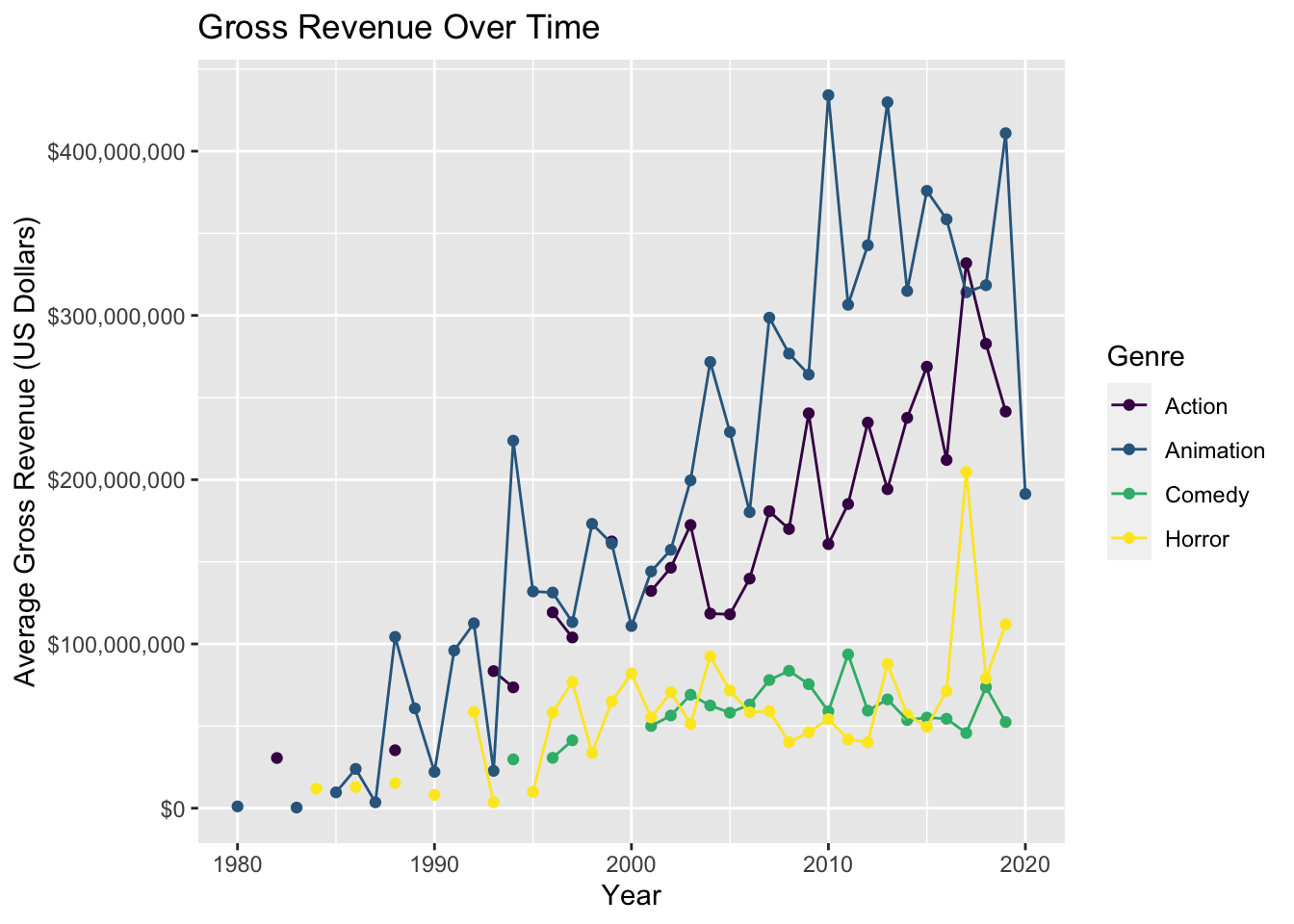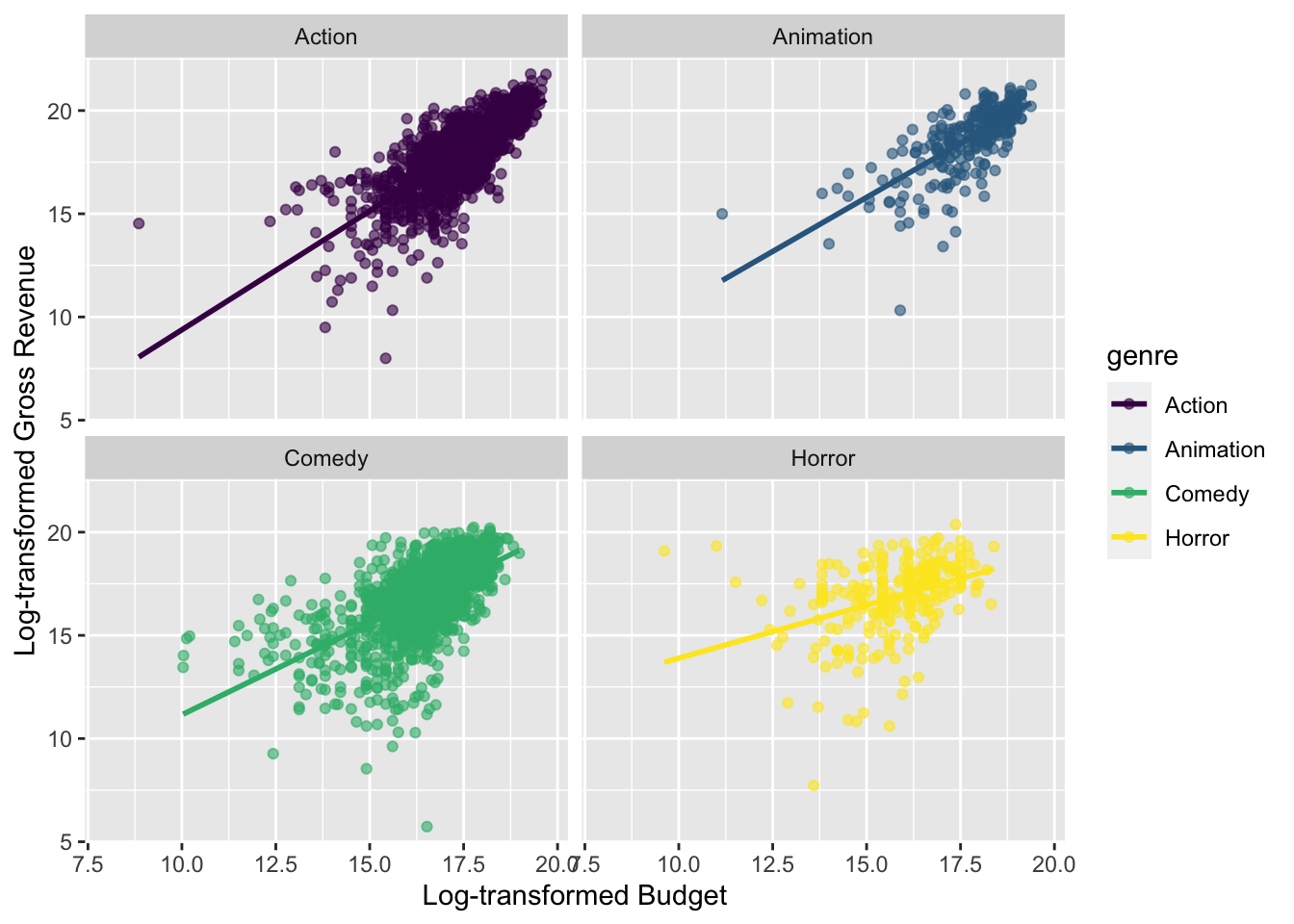library(tidyverse) # for data analysis and visualisation
library(scales) # for pretty axis labels
library(DT) # for interactive tableMovie budgets and revenues
This application exercise is a demo only. You do not have a corresponding repository for it and you’re not expected to turn in anything for it.
We will look at the relationship between budget and revenue for movies made in the United States in 1986 to 2020. The dataset is created based on data from the Internet Movie Database (IMDB).
Data
The movies data set includes basic information about each movie including budget, genre, movie studio, director, etc. A full list of the variables may be found here.
movies <- read_csv("https://raw.githubusercontent.com/danielgrijalva/movie-stats/master/movies.csv")View the first 10 rows of data.
movies# A tibble: 7,668 × 15
name rating genre year released score votes director writer star country
<chr> <chr> <chr> <dbl> <chr> <dbl> <dbl> <chr> <chr> <chr> <chr>
1 The S… R Drama 1980 June 13… 8.4 9.27e5 Stanley… Steph… Jack… United…
2 The B… R Adve… 1980 July 2,… 5.8 6.5 e4 Randal … Henry… Broo… United…
3 Star … PG Acti… 1980 June 20… 8.7 1.2 e6 Irvin K… Leigh… Mark… United…
4 Airpl… PG Come… 1980 July 2,… 7.7 2.21e5 Jim Abr… Jim A… Robe… United…
5 Caddy… R Come… 1980 July 25… 7.3 1.08e5 Harold … Brian… Chev… United…
6 Frida… R Horr… 1980 May 9, … 6.4 1.23e5 Sean S.… Victo… Bets… United…
7 The B… R Acti… 1980 June 20… 7.9 1.88e5 John La… Dan A… John… United…
8 Ragin… R Biog… 1980 Decembe… 8.2 3.3 e5 Martin … Jake … Robe… United…
9 Super… PG Acti… 1980 June 19… 6.8 1.01e5 Richard… Jerry… Gene… United…
10 The L… R Biog… 1980 May 16,… 7 1 e4 Walter … Bill … Davi… United…
# … with 7,658 more rows, and 4 more variables: budget <dbl>, gross <dbl>,
# company <chr>, runtime <dbl>The ___ dataset has ___ observations and ___ variables.
Analysis
Gross over time
We begin by looking at how the average gross revenue (gross) has changed over time. Since we want to visualize the results, we will choose a few genres of interest for the analysis.
genre_list <- c("Comedy", "Action", "Animation", "Horror")Then, we will filter for these genres and visualize the average gross revenue over time.
movies %>%
filter(genre %in% genre_list) %>%
group_by(genre,year) %>%
summarise(avg_gross = mean(gross)) %>%
ggplot(mapping = aes(x = year, y = avg_gross, color= genre)) +
geom_point() +
geom_line() +
scale_color_viridis_d() +
scale_y_continuous(labels = label_dollar()) +
labs(
x = "Year",
y = "Average Gross Revenue (US Dollars)",
color = "Genre",
title = "Gross Revenue Over Time"
)`summarise()` has grouped output by 'genre'. You can override using the
`.groups` argument.Warning: Removed 47 rows containing missing values (geom_point).Warning: Removed 23 row(s) containing missing values (geom_path).
The plot suggests …
Budget and gross
Next, let’s see the relationship between a movie’s budget and its gross revenue.
movies %>%
filter(genre %in% genre_list, budget > 0) %>%
ggplot(mapping = aes(x=log(budget), y = log(gross), color=genre)) +
geom_point(alpha = 0.6) +
geom_smooth(method = "lm", se = FALSE) +
facet_wrap(~ genre) +
scale_color_viridis_d() +
labs(
x = "Log-transformed Budget",
y = "Log-transformed Gross Revenue"
)`geom_smooth()` using formula 'y ~ x'Warning: Removed 35 rows containing non-finite values (stat_smooth).Warning: Removed 35 rows containing missing values (geom_point).
Exercises
Suppose we fit a regression model for each genre that uses budget to predict gross revenue. What are the signs of the correlation between
budgetandgrossand the slope in each regression equation?Suppose we fit the regression model from the previous question. Which genre would you expect to have the smallest residuals, on average (residual = observed revenue - predicted revenue)?
In the remaining time, discuss the following: Notice in the graph above that
budgetandgrossare log-transformed. Why are the log-transformed values of the variables displayed rather than the original values (in U.S. dollars)?
Appendix
Below is a list of genres in the data set:
movies %>%
distinct(genre) %>%
arrange(genre) %>%
datatable()